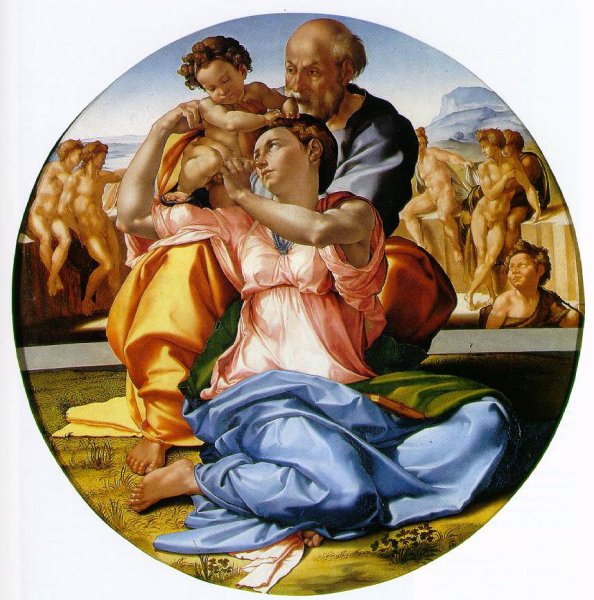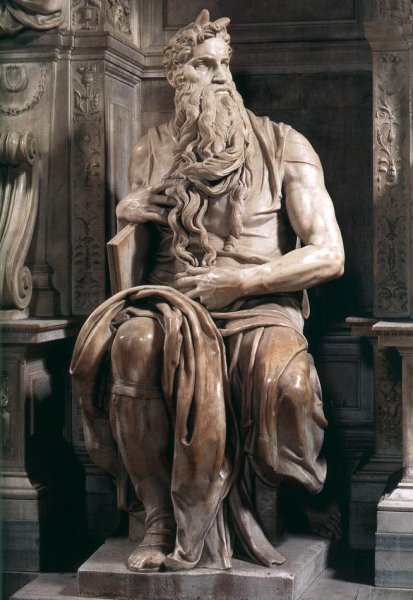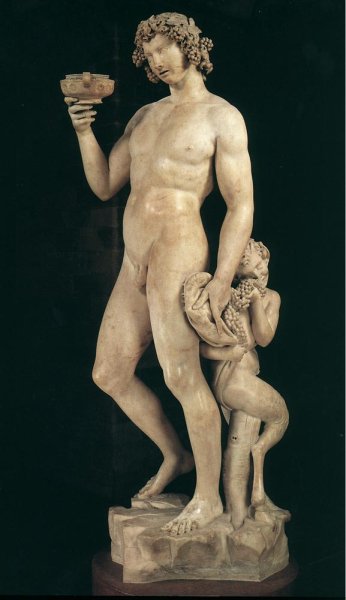Michelangelo Buonarroti Biography In Details
Biography

Early life
Michelangelo was born on March 6, 1475 in Caprese near Arezzo, Tuscany. His family had for several generations been small-scale bankers in Florence but his father, Lodovico di Leonardo di Buonarroti di Simoni, failed to maintain its status, holding to occasional government jobs. At the time of Michelangelo's birth he was Judicial administrator of small-town Caprese and local administrator of Chiusi. Michelangelo's mother was Francesca di Neri del Miniato di Siena. The Buonarroti claimed to descend from Countess Mathilde of Canossa; this claim was probably false, but Michelangelo himself believed it. However, several months after Michelangelo's birth the family returned to Florence where Michelangelo was raised. At later times, during the prolonged illness and after the death of his mother, Michelangelo lived with a stonecutter and his wife and family in the town of Settignano where his father owned a marble quarry and a small farm. Michelangelo once said to the biographer of artists Giorgio Vasari, "If there is some good in me, it is because I was born in the subtle atmosphere of your country of Arezzo. Along with the milk of my nurse I received the knack of handling chisel and hammer, with which I make my figures."
Michelangelo's father sent him to study grammar with the humanist Francesco da Urbino in Florence as a young boy. The young artist, however, showed no interest in school, preferring instead to copy paintings from churches and seek the company of painters. Michelangelo was apprenticed in painting with Domenico Ghirlandaio and in sculpture with Bertoldo di Giovanni. Michelangelo's father managed to persuade Ghirlandaio to pay the 14-year-old artist, which was highly unusual at the time. When in 1489 Florence's ruler Lorenzo de' Medici asked Ghirlandaio for his two best pupils, Ghirlandaio sent Michelangelo and Francesco Granacci. From 1490 to 1492, Michelangelo attended Lorenzo's school and was influenced by many prominent people who modified and expanded his ideas on art, following the dominant Platonic view of that age, and even his feelings about sexuality. It was during this period that Michelangelo met literary personalities like Pico della Mirandola, Angelo Poliziano and Marsilio Ficino. Michelangelo finished Madonna of the Steps (1490-1492) and Battle of the Centaurs (1491-1492). The latter was based on a theme suggested by Poliziano and was commissioned by Lorenzo de Medici.
Early adulthood
Lorenzo's death on April 8, 1492, brought a complete reversal of Michelangelo's circumstances. Michelangelo left the security of the Medici court and returned to his father's house. In the following months he produced a Wooden crucifix (1493), as a gift to the prior of the church of Santa Maria del Santo Spirito who had permitted him some studies of anatomy on the corpses of the church's hospital. Between 1493 and 1494 he bought the marble for a larger than life statue of Hercules, which was sent to France and disappeared sometime in the 1700s. He re-entered the court on January 20, 1494, when, after a great deal of snow had fallen, the young Piero de Medici commissioned a snow statue from him.
The same year, however, the Medici were expelled from Florence after the rise of Savonarola, while Michelangelo had left the city before the end of the political upheaval, moving to Venice and then to Bologna. Here he was commissioned to finish the carving of the last small figures of the tomb and shrine of St. Dominic, in the church with the same name. He returned to Florence at the end of 1494, as Charles VIII had suffered defeats and Florence was no longer in danger of being sacked by the French. He did not receive any commissions from the new city government under Savonarola, and so linked up with the Medicis. During the half year he spent in Florence he worked on two statuettes; a child St. John the Baptist and a sleeping Cupid. Supposedly, his commissioner, Lorenzo de Pierfrancesco 'de Medici, for whom Michelangelo had sculpted St. John the Baptist, asked that Michelangelo "fix it so that it looked as if it had been buried" so he could "send it to Rome pass [it off as] an ancient work and sell it much better." Both Lorenzo and Michelangelo were unwittingly cheated out of the real value of the piece by a middleman. Cardinal Raffaele Riario, to whom Lorenzo had sold it, found out that it was a fraud, but was so impressed by the quality of the sculpture that he invited the artist to Rome. This apparent success in selling his sculpture abroad as well as the conservative Florentine situation may have encouraged Michelangelo to accept the prelate's invitation.
Rome
On June 25, 1496 at the age of 21, Michelangelo arrived in Rome. On July 4 Michelangelo started to carve an over-life-size statue of the Roman wine god, Bacchus, commissioned by Cardinal Raffaele Riario; the work was rejected by the cardinal, and subsequently entered the collection of the banker Jacopo Galli, for his garden.
Subsequently, in November of 1497, the French ambassador in the Holy See commissioned one of his most famous works, the Pieta. The contemporary opinion about this work - "a revelation of all the potentialities and force of the art of sculpture" - was summarized by Vasari: "It is certainly a miracle that a formless block of stone could ever have been reduced to a perfection that nature is scarcely able to create in the flesh."
The contract was agreed in the August of the following year. Though he devoted himself mainly to sculpture, during his first stay in Rome Michelangelo never stopped his daily practice of drawing. In Rome, Michelangelo lived near the church of Santa Maria di Loreto: here, according to the legends, he fell in love with Vittoria Colonna, marquise of Pescara and poet. His house was demolished in 1874, and the remaining architectural elements saved by the new proprietors were destroyed in 1930. Today a modern reconstruction of Michelangelo's house can be seen on the Gianicolo hill.
Personality

Michelangelo, who was often arrogant with others and constantly dissatisfied with himself, saw art as originating from inner inspiration and from culture. In contradiction to the ideas of his rival, Leonardo da Vinci, Michelangelo saw nature as an enemy that had to be overcome. The figures that he created are forceful and dynamic; each in its own space apart from the outside world. For Michelangelo, the job of the sculptor was to free the forms that were already inside the stone. He believed that every stone had a sculpture within it, and that the work of sculpting was simply a matter of chipping away all that was not a part of the statue.
Several anecdotes reveal that Michelangelo's skill, especially in sculpture, was greatly admired in his own time. Another Lorenzo de Medici wanted to use Michelangelo to make some money. He had Michelangelo sculpt a cupid that looked worn and old. Lorenzo paid Michelangelo 30 ducats, but sold the cupid for 200 ducats. Cardinal Raffaele Riario became suspicous and sent someone to investigate. The man had Michelangelo do a sketch for him of a cupid, and then told Michelangelo that while he received 30 ducats for his cupid, Lorenzo had passed the cupid off for an antique and sold it for 200 ducats. Michelangelo then confessed that he had done the cupid, but had no idea that he had been cheated. After the truth was revealed, the Cardinal later took this as proof of his skill and commissioned his Bacchus. Another better-known anecdote claims that when finishing the Moses (San Pietro in Vincoli, Rome), Michelangelo violently hit the knee of the statue with a hammer, shouting, "Why don't you speak to me?"
In his personal life, Michelangelo was abstemious. He told his apprentice, Ascanio Condivi: "However rich I may have been, I have always lived like a poor man." Condivi said he was indifferent to food and drink, eating "more out of necessity than of pleasure" and that he "often slept in his clothes and ... boots." These habits may have made him unpopular; his biographer Paolo Giovio says "His nature was so rough and uncouth that his domestic habits were incredibly squalid, and deprived posterity of any pupils who might have followed him." He may not have minded, since he was by nature a solitary and melancholy person; he had a reputation for being bizzarro e fantastico because he "withdrew himself from the company of men."
Sexuality

Fundamental to Michelangelo's art is his love of male beauty, which attracted him both aesthetically and emotionally. In part, this was an expression of the Renaissance idealization of masculinity. But in Michelangelo's art there is clearly a sensual response to this aesthetic. Such feelings caused him great anguish, and he expressed the struggle between Platonic ideals and carnal desire in his sculpture, drawing and his poetry, too, for among his other accomplishments Michelangelo was also a great Italian lyric poet of the 16th century.
The sculptor's expressions of love have been characterized as both Neoplatonic and openly homoerotic; recent scholarship seeks an interpretation which respects both readings, yet is wary of drawing absolute conclusions. One example of the conundrum is the story of the sixteen year old Cecchino dei Bracci, whose death, only a year after their meeting in 1543, inspired the writing of forty eight funeral epigrams, which by some accounts allude to a relationship that was not only romantic but physical as well:
La carne terra, e qui l'ossa mia, prive
de' lor begli occhi, e del leggiadro aspetto
fan fede a quel ch'i' fu grazia nel letto,
che abbracciava, e' n che l'anima vive.
or
The flesh now earth, and here my bones,
Bereft of handsome eyes, and jaunty air,
Still loyal are to him I joyed in bed,
Whom I embraced, in whom my soul now lives.
According to others, they represent an emotionless and elegant re-imagining of Platonic dialogue, whereby erotic poetry was seen as an expression of refined sensibilities (Indeed, it must be remembered that professions of love in 16th century Italy were given a far wider application than now). Some youths were street wise and took advantage of the sculptor. Febbo di Poggio, in 1532, peddled his charms-in answer to Michelangelo's love poem he asks for money. Earlier, Gherardo Perini, in 1522, had stolen from him shamelessly. Michelangelo defended his privacy above all. When an employee of his friend Niccolo Quaratesi offered his son as apprentice suggesting that he would be good even in bed, Michelangelo refused indignantly, suggesting Quaratesi fire the man.
The greatest written expression of his love was given to Tommaso dei Cavalieri (c. 1509-1587), who was 23 years old when Michelangelo met him in 1532, at the age of 57. Cavalieri was open to the older man's affection: I swear to return your love. Never have I loved a man more than I love you, never have I wished for a friendship more than I wish for yours. Cavalieri remained devoted to Michelangelo till his death.
Michelangelo dedicated to him over three hundred sonnets and madrigals, constituting the largest sequence of poems composed by him. Some modern commentators assert that the relationship was merely a Platonic affection, even suggesting that Michelangelo was seeking a surrogate son. However, their homoerotic nature was recognized in his own time, so that a decorous veil was drawn across them by his grand nephew, Michelangelo the Younger, who published an edition of the poetry in 1623 with the gender of pronouns changed. John Addington Symonds, the early British homosexual activist, undid this change by translating the original sonnets into English and writing a two-volume biography, published in 1893.
The sonnets are the first large sequence of poems in any modern tongue addressed by one man to another, predating Shakespeare's sonnets to his young friend by a good fifty years.
I feel as lit by fire a cold countenance
That burns me from afar and keeps itself ice-chill;
A strength I feel two shapely arms to fill
Which without motion moves every balance. - (Michael Sullivan, translation)
Late in life he nurtured a great love for the poet and noble widow Vittoria Colonna, whom he met in Rome in 1536 or 1538 and who was in her late forties at the time. They wrote sonnets for each other and were in regular contact until she died, though many scholars note the intellectualized or spiritual quality of this passion.
It is impossible to know for certain whether Michelangelo had physical relationships (Condivi ascribed to him a "monk-like chastity"), but through his poetry and visual art we may at least glimpse the arc of his imagination. (From Wikipedia)



![Ceiling of the Sistine Chapel [detail]](/media/slider/paintingsL/112850/ceiling-of-the-sistine-chapel-.jpg)
